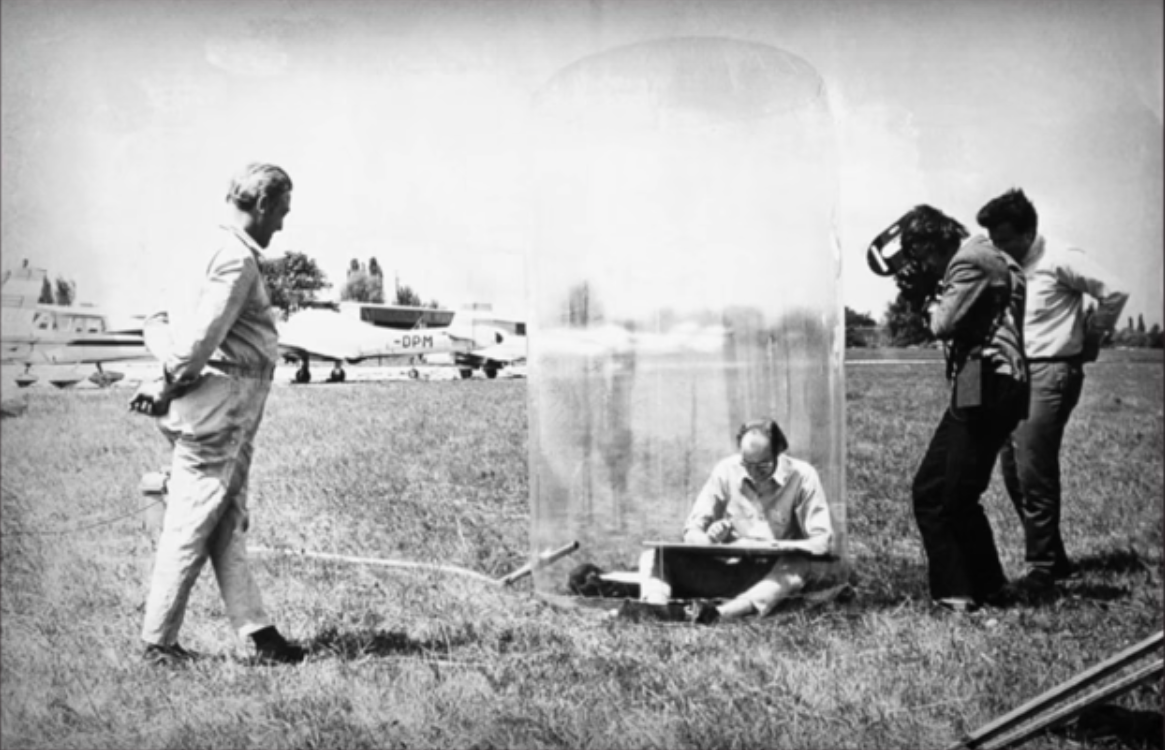In 1969, Hans Hollein, then a 35-year-old rising star of architecture, was sitting in a field at the airport in Vienna underneath a thin plastic tube, chattering away on the telephone and sketching a house. This was broadcast on Austria’s national television network: “Mobiles Büro,” or “Mobile Office.”
It looks like a portal into outer-space from a sci-fi movie, or perhaps an elaborate defense against allergies, or a kind of snowglobe. But it’s Hollein’s vision for a portable workspace, one that you can stuff into your suitcase and pop out at any opportunity; even if you’ve just stepped off a jet-plane, you can quite literally set up shop.
“Modern man that today changes from place to place no longer stays in one box, but wants to carry around with him different dwellings,” Hollein said (or the English subtitles on a video of an interview in German say that he said). “Everywhere I find a hoover or compressed air, I can inflate this structure.” The video shows him unloading yards of PVC plastic from a small suitcase, blowing it up into a tent-like shape, wriggling underneath it, and starting to work. The telephone next to him rings.
“Yes, I just finished the design of the house. It will be delivered to you immediately,” Hollein says, holding a ruler to his drawing board. “Yes, a very modern design. Yes, exactly how you ordered it.” The camera then pans to his drawing, which looks like a little fairytale cottage with a curl of pencil smoke coming out of its chimney. He adds another flourish of smoke and smiles from behind his sunglasses.
“Mobile Office” was as much a performance piece as a design, with Hollein starring as the cosmopolitan, global, creative, professional man—the kind of man no longer tethered to the confines of a 9-to-5 workday in a single city, but liberated by the miracle of air travel and other technology. Hollein was idealistic like many people in the 60s and 70s about these changes in the structure of labor after World War II. “Mobile Office” was a response to all of this, a way of using design optimistically to imagine the future of work. In it, the workplace is permeable and public, divided only by plastic from the rest of the world.
My last day of my most recent stint in an “office” was June 16, 2018. For the past not-quite-year I have done work on my laptop or phone from four different apartments, dozens and dozens of coffee shops, and two coworking spaces (one I grifted my way into and one I joined for a month before deciding it wasn’t worth it for me to pay a couple hundred dollars monthly for “the office experience”). I’ve also worked at friends’ houses; in libraries; on planes, trains, buses, and in cars; in the stairwell of more than one museum; on the lift chair at a ski slope; on the top of a mountain; at the beach; at the side of an ice-skating rink; on the stationary bike (and, I’ll admit, once, on the treadmill); in a bunch of restaurants and bars; on the sidewalk; at Safeway, and in many bathroom stalls (great place to take private calls). This is not all that unusual, I don’t think, though it does sound slightly insane, and I almost certainly take it to an extreme.
I am not at all eager to return to “an office,” by which I mean, a badly lit open-plan space where a lot of people are talking loudly on the telephone or alternately listening to me talk. I am not eager to have “regular hours” that would then be infringed upon or to trade the freedom of movement I now have for “stability” that would in all likelihood be a myth. I am, however, mildly appalled by the sprawl of my workplace into…everywhere else. I do think it is mildly dystopian that a lot of people who are, like me, often at the whim of big companies for dwindling amounts of money they won’t see for a few months or possibly ever (hello, Hearst, I would like my $250 please) are hunched over laptops in cafés for hours on end after paying $2-4 for a coffee (and, if they have any morals, tipping the person who makes it) and then drinking tap water all day while jockeying for power outlets. I think it is strange how normal this scene looks to us.
What I like about watching Hollein’s “Mobile Office” today is the same thing I like about many predictions or designs for the future that were made in the past: they un-normalize conditions of contemporary life. “Mobile Office” is, you might say, prescient, in the sense that Hollein observed the trends of postwar labor conditions in the U.S. and designed for them, thereby in some sense predicting what was coming. “Mobile Office” is the collapse of the workplace literalized. But on the other hand, it looks obviously absurd to us, because it’s a guy sitting in a field in a plastic bubble talking on the phone.
What Hollein “got wrong” (although he didn’t get it wrong so much as society did) was the idea that there would be any kind of dividing line at all between workspace and other space. There is no boundary between my world and my workplace, except perhaps when I am asleep. I feel, sometimes, like I am a literal mobile office, and there’s no bubble around me at all.






